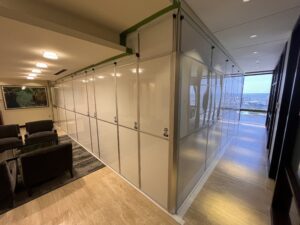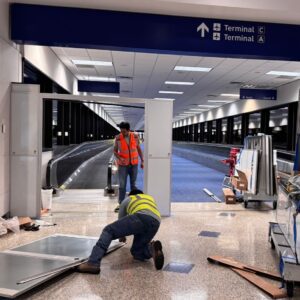Temporary Walls vs. Drywall Construction
Temporary Walls vs. Drywall Construction: Cost, Efficiency, and Flexibility
Choosing the right wall solution for your construction project can significantly impact your timeline, budget, and overall success. For construction managers, the debate often centers around two primary options: temporary walls and drywall construction. Each option comes with distinct benefits and limitations, and understanding how they compare in terms of cost, efficiency, flexibility, and environmental impact is essential to making the best choice for your project.
This guide provides a comprehensive comparison of temporary walls and drywall systems, making it easier to align your decision with your specific project requirements.
Cost Analysis
Initial Costs
- Temporary Walls: Temporary walls often have lower upfront costs due to their rentable nature. Many providers, including Temporary Wall Systems, offer package deals that cover delivery, installation, and teardown, eliminating the need to purchase materials outright.
- Drywall Construction: Drywall requires upfront investment in raw materials (e.g., drywall boards, screws, mud, and paint) as well as additional equipment if you don’t already have these on hand. Drywall generally costs between $0.40 and $3.00 per square foot, depending on the project requirements.
Long-Term Costs
- Temporary Walls: Reusability and rental options drastically reduce overall costs for projects requiring short-term barriers. Since these walls can be removed and reused by the provider, you’re not stuck with disposal fees or leftover materials.
- Drywall Construction: While drywall may seem like a cost-effective solution, long-term expenses can add up. Demolition, waste disposal, and reconstruction for future adjustments can make it a more expensive option in projects requiring flexibility.
Temporary walls typically offer a more economical solution for short-term or modular applications, while drywall might be a better investment for permanent structures.
Installation and Time Efficiency
Installation Time
- Temporary Walls: Installation for temporary walls is exceptionally fast, often requiring only a few hours. These walls come pre-fabricated and don’t demand complex construction or finishing processes.
- Drywall Construction: Installing drywall is labor-intensive. It involves framing, cutting, attaching panels, taping seams, applying joint compound, sanding, and finally painting. This step-by-step process can take several days, especially for larger projects.
Labor Requirements
- Temporary Walls: With turnkey services, temporary wall providers handle the entire setup process, from delivery to removal, minimizing labor requirements on your end.
- Drywall Construction: Requires a skilled team and significant manual labor, which can increase workforce needs and inflate labor costs.
Flexibility and Reconfigurability
- Temporary Walls: Ideal for dynamic project environments, temporary walls can be adjusted, relocated, or removed as your needs evolve. For instance, Temporary Wall Systems offers customizable solutions that allow you to reconfigure spaces quickly without the need for demolition.
- Drywall Construction: Once installed, drywall is a permanent solution. Making changes or adjustments involves demolition and reconstruction, which can be time-intensive and costly.
Multi-Purpose Applications
For projects requiring multi-functional spaces or phased renovations, temporary walls provide the flexibility to partition areas without committing to a fixed layout.
Temporary walls win out in projects where adaptability is crucial, whereas drywall excels in creating permanent spaces.
Environmental Impact
- Temporary Walls: Designed to be reused multiple times, temporary walls significantly reduce construction waste. Providers like Temporary Wall Systems maintain environmentally friendly practices by handling removal and reuse processes.
- Drywall Construction: Drywall waste represents a considerable percentage of landfill material from construction projects. Its single-use nature and the difficulty of recycling drywall sheets contribute to its environmental footprint.
Temporary walls provide efficiency, adaptability, and environmental benefits, making them a smart choice for temporary setups, phased construction projects, and dynamic environments. On the other hand, drywall is an excellent option for static, permanent installations.
At Temporary Wall Systems, we specialize in high-quality, reusable wall solutions delivered with full-service ease. From helping you partition your workspace to creating adaptable environments, we take the hassle out of installation, removal, and everything in between.


